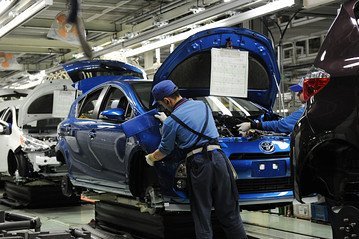Japan’s Big Car Makers Grapple With Strong Yen

Toyota Motor Corp., long the country’s biggest auto exporter, is turning to an underutilized factory in northern France to build a version of its Yaris subcompact for the U.S., cutting exports from Japan. It is the only model from any of the Japanese Big Three to be exported from continental Europe to the U.S., reflecting the plunge of the euro versus the yen and dollar.
All three of Japan’s biggest auto companies—Toyota, Nissan Motor Co. and Honda Motor Co.—have been slowly shifting production abroad over the past decade, reflecting the yen’s rise against other currencies and faster growth in overseas markets. But in recent weeks those efforts have accelerated. Last month, a Honda executive said it isn’t pushing some exports to the U.S., including its Honda Fit subcompact, because the strong yen has rendered the exports barely profitable.
“The era of wait-and-see is over. Japanese manufacturers realize they need to move quickly or risk losing competitiveness,” said Satoshi Komiya, a managing director at Boston Consulting Group in Tokyo. “In one sense, the recent surge in the yen’s value has given them cover to reduce their manufacturing footprint as they’ve long wanted to do.”
The yen’s rise has been steep over the past four years. The dollar has weakened 28% against the Japanese currency since 2008, while the euro has fallen 39%. Despite efforts to wring savings out of their domestic manufacturing operations, Japanese auto makers have struggled to compete on price and profitability with their U.S., German and South Korean rivals.
Many of Europe’s big auto makers are investing heavily outside of the euro zone to reduce their exposure to exchange-rate fluctuations. Volkswagen AG, which last year opened a $1 billion U.S. plant to build passenger cars, now plans to make Audi luxury cars for North America in Mexico beginning in 2016. BMW AG is increasing capacity in the U.S. and has plans to build a new factory in Brazil. Daimler AG recently expanded its U.S. production of Mercedes-Benz. Meantime, Europe’s mass-market auto makers are suffering from excess capacity.
Akio Toyoda, Toyota’s president, has warned the strong yen is threatening to hollow out Japan’s industrial might. Trade group Japan Automobile Manufacturers Association, which Mr. Toyoda leads, calculates auto shipments from Japan shrank to 4.4 million last year from 6.5 million vehicles in 2007. Estimates for 2012 aren’t available.
Toyota has long positioned itself as a bulwark of Japan-centric manufacturing and has said it remains committed to keeping production of at least three million vehicles a year in Japan. But the toll of the yen has been high, shrinking profits and blunting the price competitiveness of its Japanese-made models. In May, the auto maker posted a ¥207 billion operating loss ($2.6 billion) for its export-heavy Japanese operations in its most recent fiscal year.
As recently as 2005, Toyota’s average exchange rate was ¥113 to the dollar. But by 2010 the exchange rate averaged ¥86 to the dollar. This year, the company forecasts an average of ¥80 to the dollar. The company has said it expects to maintain domestic production at about three million vehicles a year by expanding its share of the local market to make up for shifts abroad.
Toyota is more exposed to currency risk than rivals with 41% of its global volume last year manufactured in Japan, compared with 28% for Honda and 35% for Nissan. The auto maker said exports from France to North America would begin in May 2013. “The guiding principle is to ensure maximum capacity utilization,” said Didier Leroy, president of Toyota Motor Europe. “We have excess capacity in Europe, and less in Japan.”
Nissan said this month it would end mass production at one of two assembly lines at its factory in Oppama, Japan, that makes several Japanese-market vehicles. Nissan hasn’t decided the fate of those two cars, according to a spokesman. But Japan’s Nikkei newspaper reported on Thursday the company will completely replace one vehicle with a Thai import and procure all core parts of another from Thailand.
The No. 2 Japanese auto maker has already relocated production of some Japan market models to overseas plants, including a Thai-made subcompact, and has plans to move more, such as its Rogue crossover, to Canton, Miss. In February, Nissan began building its first luxury car outside of Japan, the Infiniti JX crossover, in Smyrna, Tenn. CEO Carlos Ghosn has hinted more models will move offshore if the yen stays at current levels.
Honda, the fastest of the three to build up manufacturing operations outside Japan, plans to export up to 150,000 vehicles a year from its North American plants by 2017, according to a spokesman. Meantime, the spokesman said the car maker is considering abandoning domestic production of the Japan-market equivalent of the U.S. Acura RL when that sedan is replaced with the RLX model in early 2013. It recently began exporting Chinese-made Fits to Canada.
That comes after Honda President Takanobu Ito announced a new strategy last year to cut the percentage of exports from Japan to between 10% and 20% of its domestic production, down from about between 30% and 40% currently. The shortfall will be made up by lifting exports from the U.S. and other markets to between 10% and 20% of annual output.


